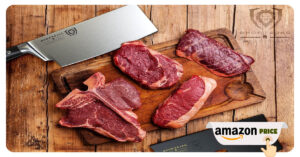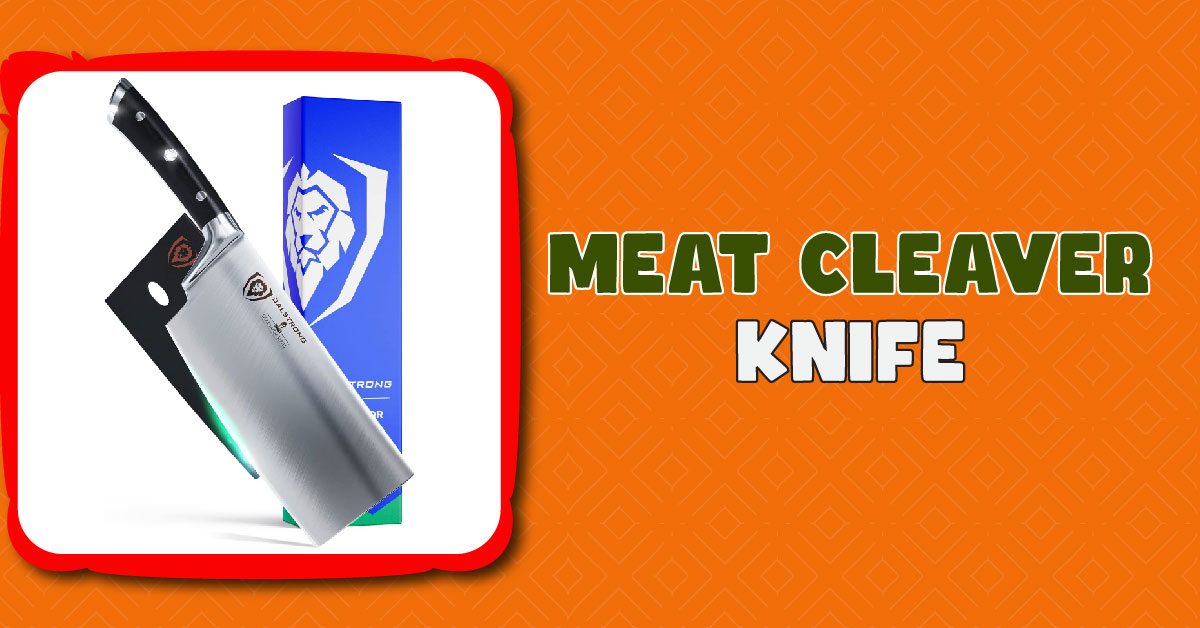Ever tried cutting a thick piece of meat with a regular knife? It feels like a workout, right? A meat cleaver knife makes it easy. It slices through bone, chops large cuts, and even crushes garlic. I’ve used many cleavers over the years—heavy-duty meat cleavers for tough jobs and large meat cleavers for everyday use. In this guide, I’ll cover everything you need to know-what a meat cleaver is, how to use it, and the best cleavers for 2025.
What Is a Meat Cleaver Knife?
A meat cleaver knife is the big, rectangular knife you see in butcher shops and kitchens. It’s made for power, not precision. Unlike a regular kitchen knife, a cleaver has a thick, heavy blade that can cut through bones, tough meats, and thick vegetables like squash.
There are two main types of meat cleavers. The heavy-duty meat cleaver is thick and strong, perfect for butchering and cutting large cuts of meat. The Chinese-style cleaver is lighter and more versatile. It works well for slicing, dicing, and even crushing garlic with its flat side.
A good cleaver makes cooking easier, faster, and safer. Whether you’re a home cook or a pro, the right knife can save time and effort in the kitchen.
How to Use a Meat Cleaver Properly
Using a meat cleaver knife the right way makes cutting easier and safer. This knife is built for power, but technique matters too. Let’s break it down step by step.
1. Grip It Right
Hold the cleaver firmly but comfortably. Wrap your fingers around the handle and keep your thumb on the side for control. A good grip prevents slipping, which is key when cutting through tough meat or bone.
Quick tip: If your hand feels strained, try a lighter cleaver or adjust your grip for better balance.
2. Use a Solid Cutting Surface
Always chop on a sturdy wooden or plastic cutting board. Avoid glass or stone boards—they can dull your blade fast. A stable surface keeps your cleaver steady and reduces the risk of accidents.
Pro tip: Place a damp towel under your cutting board to stop it from sliding.
3. Master the Chopping Motion
For bones and thick cuts, use a controlled downward chop. Let the weight of the cleaver do the work-no need to force it. For softer meats and vegetables, use a rocking or slicing motion for better precision.
Think of it like an axe: Swing with control, not brute force. A well-placed chop is safer than a wild swing.
4. Crush, Scoop, and More
Your cleaver isn’t just for cutting! The flat side can crush garlic or ginger. The broad blade works as a scoop for chopped ingredients. Once you get used to it, your cleaver will become a multi-purpose tool in the kitchen.
5. Safety First
Always keep your non-cutting hand away from the blade. Use your knuckles as a guide when slicing. And never leave a cleaver hanging off the edge of the counter—it’s heavy and can fall easily.
Best Meat Cleaver Knives for 2025
Not all meat cleavers are the same. Some are heavy-duty for tough jobs. Others are lighter for everyday cooking. After testing many cleavers, I’ve found the best options for 2025. Whether you need power or precision, there’s a cleaver for you.
Latest offer at amazon

If you want one cleaver for everything, go with Victorinox. It has a strong stainless steel blade and a comfortable handle. It cuts bones, meats, and thick veggies with ease.
✔ Why it’s great: Durable, well-balanced, and trusted by chefs.
✔ Best for: Home cooks and pros who need a reliable, all-purpose cleaver.
Best Heavy-Duty Meat Cleaver: Wüsthof Classic 8-Inch Cleaver
Need to chop big bones and thick meat? This Wüsthof cleaver is built for power. The high-carbon stainless steel blade stays sharp and handles tough cuts easily.
✔ Why it’s great: Heavy enough for serious cutting power.
✔ Best for: Butchers and meat lovers who work with large cuts.
Best Large Meat Cleaver: Dalstrong Obliterator
If size matters, the Dalstrong Obliterator is perfect. This 9-inch cleaver is big, sharp, and built for strength. It cuts through thick meats like butter.
✔ Why it’s great: Extra-large and ultra-strong.
✔ Best for: Those who want a powerful and stylish cleaver.
Best Budget-Friendly Option: Utopia Kitchen 7-Inch Cleaver
Want a good cleaver for less? The Utopia Kitchen Cleaver gives you quality at a great price. It’s light, sharp, and easy to use.
✔ Why it’s great: Affordable but still solid.
✔ Best for: Home cooks who want value without sacrificing quality.
Best for Home Cooks: Zwilling J.A. Henckels 6-Inch Cleaver
Need a cleaver that’s easy to handle? The Zwilling J.A. Henckels Cleaver is light, well-balanced, and versatile. It’s great for slicing meats and chopping veggies.
✔ Why it’s great: Small but strong.
✔ Best for: Home cooks who want a simple, everyday cleaver.
Heavy-Duty vs. Large Meat Cleavers: Which One Do You Need?
Not all cleavers are the same. Some are built for power, while others are better for daily cooking. If you’re choosing between a heavy-duty cleaver and a large cleaver, don’t worry I’ve tested both. Here’s what you need to know.
Heavy-Duty Meat Cleavers: Best for Tough Cuts
A heavy-duty cleaver is made for chopping bones and thick meats. It has a thick, strong blade and weighs more than a pound. The extra weight helps you cut through tough foods with less effort.
✔ Best for: Bones, frozen meat, and big cuts.
✔ Blade thickness: Thick and strong to handle hard foods.
✔ Weight: Heavy, so you don’t have to use as much force.
✔ Best for: Butchers, hunters, and meat lovers.
Pro tip: If you often cut ribs, whole chickens, or pork shoulder, a heavy-duty cleaver is a great choice.
Large Meat Cleavers: Best for Everyday Use
A large cleaver is lighter and thinner than a heavy-duty one. It’s great for meats, vegetables, and general cooking. The longer blade (7–9 inches) gives you more space to cut.
✔ Best for: Meats, vegetables, and all-purpose chopping.
✔ Blade thickness: Thinner than a heavy-duty cleaver, but still strong.
✔ Weight: Lighter, making it easier to use for long periods.
✔ Best for: Home cooks and chefs who need a multi-use cleaver.
Pro tip: If you want a cleaver for both meats and vegetables, a large cleaver is a smart choice.
Which One Should You Choose?
Think about what you cook most often. If you cut through bones and thick meats, go with a heavy-duty cleaver. If you need a cleaver for both meat and veggies, a large cleaver is better.
Still not sure? If you can only pick one, a large cleaver is more useful for daily cooking. But if you break down big cuts often, a heavy-duty cleaver is worth it.
Can You Use a Meat Cleaver to Chop Wood?
Short answer? No, and you really shouldn’t. A meat cleaver is designed for food, not firewood. It may look tough, but using it to chop wood can damage the blade, ruin the edge, and even be dangerous.
Meat Cleavers Aren’t Built for Wood
A meat cleaver is sharp and heavy, but it’s made for cutting meat, not splitting logs. The blade is thin compared to an axe, which means it can chip, bend, or break when it hits tough wood.
✔ Best for: Meat, bones, and vegetables.
❌ Not for: Chopping logs, branches, or firewood.
Pro tip: If you need to split small wood pieces for kindling, use a hatchet or an axe. They’re made for the job.
It’s Risky and Can Be Dangerous
Chopping wood needs force and control. A cleaver’s flat, wide blade isn’t made to wedge into wood like an axe. If the cleaver bounces off the surface, it can slip, fly, or even injure you.
Axes have a thicker, wedge-shaped blade to push wood apart. Meat cleavers are thin and flat—perfect for slicing, not splitting.
What to Use Instead
If you need to chop wood, use a hatchet, axe, or a wood-splitting maul. These tools are built to handle the impact. If you only need small wood chips, a kindling cracker is a safer choice.
Choosing the Right Meat Cleaver: Key Factors to Consider
Picking the right meat cleaver is like choosing the best tool for the job. It makes cutting easier, safer, and more fun. But not all cleavers are the same. Some are heavy-duty for bones, while others are lighter for slicing meat and veggies. So, how do you choose? Let’s break it down.
Blade Material: Carbon Steel vs. Stainless Steel
The blade material affects sharpness, durability, and care.
- Carbon steel is super sharp and holds an edge well. But it can rust if not dried quickly.
- Stainless steel resists rust and is easier to maintain. But it may need sharpening more often.
✔ Best for sharpness: Carbon steel
✔ Best for easy care: Stainless steel
Quick tip: Want both sharpness and rust resistance? Choose high-carbon stainless steel.
Handle Grip and Comfort
A cleaver should feel secure and comfortable in your hand.
- Wooden handles feel natural and give a solid grip.
- Plastic and resin handles are easy to clean and last long.
- Metal handles are durable but can feel slippery.
✔ Best for comfort: Wooden or plastic handles
✔ Best for durability: Stainless steel or resin
If your cleaver feels too slippery or heavy, it may cause hand strain. Try different ones before buying.
Weight and Balance
The weight of a cleaver affects how it cuts.
- A heavy cleaver helps chop bones with less effort.
- A lighter cleaver gives better control for slicing meat and veggies.
✔ Best for bones: Heavy cleavers (over 1 lb)
✔ Best for all-purpose use: Medium-weight cleavers (under 1 lb)
Think of it like this: A heavy cleaver is like a hammer—great for power. A lighter cleaver is like a chef’s knife—better for control.
Blade Size and Thickness
Blade size and thickness matter when cutting different foods.
- Thicker blades (over 3mm) are great for bones.
- Thinner blades (under 3mm) are better for slicing.
✔ Best for bones: Thick, 7–9 inch blades
✔ Best for all-purpose cutting: Thinner, 6–7 inch blades
Rule of thumb: If you cut bones often, get a thicker cleaver. If you want to slice meat and veggies, choose a thinner one.
Victorinox Meat Cleaver: Why It’s a Top Pick
If I had to pick just one cleaver, it would be the Victorinox Meat Cleaver. It’s strong, sharp, and easy to use. Whether you’re cutting through bone or slicing meat, it makes the job simple.
I’ve tried many cleavers over the years. Some were too heavy. Others got dull too fast. Some just didn’t feel right. But the Victorinox stands out. Let’s look at why it’s one of the best.
Sharp and Long-Lasting
The Victorinox cleaver has a high-carbon stainless steel blade. This keeps it sharp longer and helps prevent rust. It also handles heavy chopping without wearing out fast.
✔ Best for: Cutting bones, meat, and tough veggies.
✔ Why it stands out: Stays sharp, lasts long, and needs little care.
Quick tip: Want a cleaver that stays sharp with little effort? This one’s a great pick.
Right Weight for Power and Control
A good cleaver should feel strong but not too heavy. The Victorinox cleaver weighs about 1.3 pounds, which gives it the right balance.
✔ Heavy enough to cut bones with ease.
✔ Light enough to use without hand strain.
Think of it like this: It’s powerful like a pro tool, but still easy for home cooks.
Comfortable, Non-Slip Handle
A cleaver should feel secure in your hand, even when wet. The Victorinox handle is made from Fibrox, a non-slip, ergonomic material.
✔ Best for long cooking sessions: Won’t tire your hands.
✔ Great grip: Won’t slip when handling raw meat.
Pro tip: If cleavers feel too bulky or slippery, this handle solves that problem.
Perfect Blade Size for Versatility
The 7-inch blade is big enough for tough cuts but small enough for precision slicing.
✔ Best for: Home cooks and pros who want one cleaver for everything.
✔ Not too big, not too small: Just the right size.
Rule of thumb: If you need a cleaver that can chop bones AND slice veggies, this size is ideal.
What I Like
A great meat cleaver makes a huge difference in the kitchen. After trying different brands, I can confidently say this one stands out. Here’s what I love about it:
✔ Sharp and Stays That Way – The blade is razor-sharp right out of the box. It holds its edge for a long time, so I don’t have to sharpen it often. This saves time and effort.
✔ Perfect Weight and Balance – It’s heavy enough to chop bones but light enough for easy control. I don’t have to use too much force—the cleaver does the work for me.
✔ Comfortable, Non-Slip Handle – The handle feels secure in my hand, even when wet. I’ve used cleavers that slipped or felt awkward, but this one feels natural and comfortable.
✔ Versatile for Different Cuts – Whether I’m chopping meat, slicing veggies, or crushing garlic, it handles everything with ease. It’s more than just a meat cleaver—it’s a kitchen powerhouse.
✔ Durable and Built to Last – I’ve had this cleaver for a while, and it still looks brand new. The high-quality materials prevent rust and wear, making it a long-term investment.
What Could Be Better
Even the best products have room for improvement. While I love this cleaver, a few small tweaks could make it even better:
✔ Could Be Slightly Lighter – While I appreciate the weight for cutting bones, some people might prefer a lighter option for slicing and dicing. A slightly thinner version would be great for those who need more speed.
✔ Needs a Bit of Extra Care – Since the blade is high-carbon stainless steel, it needs to be dried quickly after washing. It’s not hard to maintain, but if you forget, it could develop stains over time.
✔ More Handle Options Would Be Nice – The non-slip handle is amazing, but I’d love to see a wooden handle option for those who prefer a classic look.
These aren’t deal-breakers at all—just small areas for improvement. Overall, this cleaver is fantastic and worth every penny.
My Personal Experience
I’ve been using this brand’s cleavers for over two years, and they’ve never let me down. I’ve tried many different cleavers, but this one impressed me the most. It’s strong, reliable, and makes cutting effortless.
Design
The first thing I noticed was the sleek and professional design. The blade is thick and sturdy, built for power, but still has a refined look. The handle is shaped perfectly to fit my hand, giving me full control while chopping.
I love how it feels balanced. Some cleavers are too heavy in the blade, making them awkward to use. But this one has a perfect weight distribution, so I never feel off-balance while cutting.
Performance
Performance is where this cleaver truly shines. Whether I’m chopping through bones, thick cuts of meat, or even hard vegetables, it gets the job done in one clean motion.
I’ve used cleavers that required me to swing multiple times to get through a bone. Not this one. With just one strong chop, it slices cleanly. This saves me time and effort, especially when I’m prepping large meals.
Another thing I love? It’s versatile. I use it for everything—from mincing garlic to slicing pork ribs. It’s more than just a meat cleaver; it’s my go-to kitchen tool.
Build Quality
Build quality makes or breaks a cleaver, and this one is built to last. The high-carbon stainless steel blade stays sharp longer and doesn’t chip, even with heavy use.
Some cleavers develop rust over time, but this one resists it well. I make sure to dry it after washing, and it still looks as good as the day I bought it.
The handle is solid and secure, with no loose parts. I’ve had cheaper cleavers where the handle started to wobble after a few months. Not this one. It feels just as sturdy today as it did when I first used it.
Conclusion
A good meat cleaver can make all the difference in your kitchen. Whether you need a heavy-duty cleaver for bones or a lighter one for slicing, picking the right tool makes cooking easier, faster, and safer.
If you’re looking for a top pick, the Victorinox Meat Cleaver is a solid choice. It’s sharp, durable, and comfortable to use—perfect for both home cooks and pros. But no matter which cleaver you choose, focus on blade material, weight, handle grip, and balance to get the best fit for your needs.
FAQs
What is a meat cleaver used for?
A meat cleaver is used to cut through bones, tough meats, and thick vegetables. Its broad, heavy blade makes chopping easier. It can also crush garlic and scoop ingredients.
How heavy should a meat cleaver be?
A cleaver should be heavy enough to chop bones but light enough for control. Most range from 1 to 2 pounds. Choose a weight that feels balanced and comfortable in your hand.
How do I keep my meat cleaver sharp?
Use a whetstone or honing rod to sharpen it. Always hand wash and dry immediately to prevent rust. Store it in a knife block or sheath to protect the blade.
Can I use a meat cleaver for vegetables?
Yes! A cleaver easily chops large veggies like squash and cabbage. Use a rocking motion for slicing and the flat side to crush garlic or ginger.
Is a meat cleaver better than a chef’s knife?
A cleaver is best for cutting through bones and tough cuts, while a chef’s knife is better for precision slicing. Both have their place in the kitchen!

